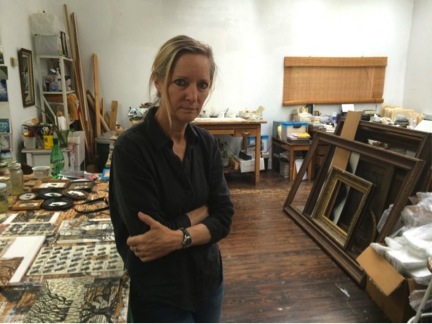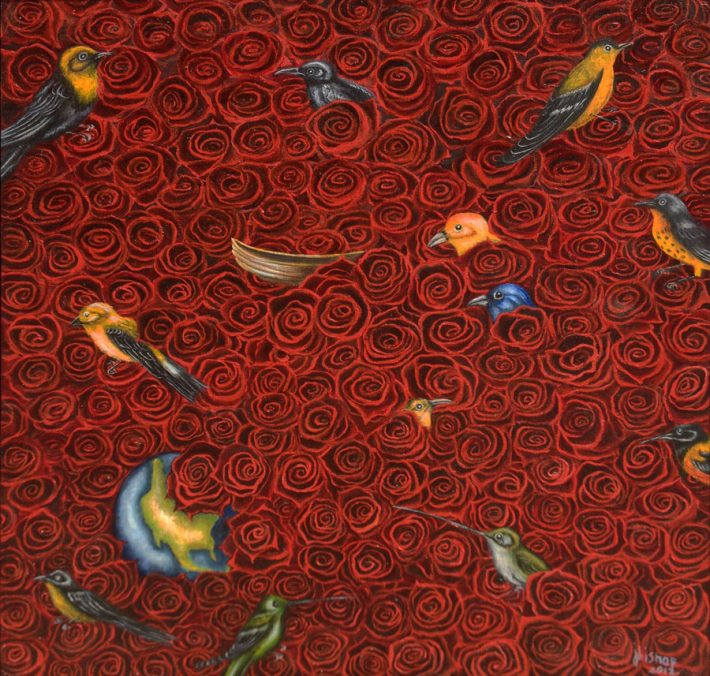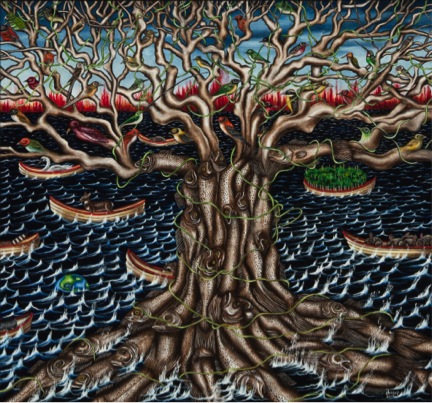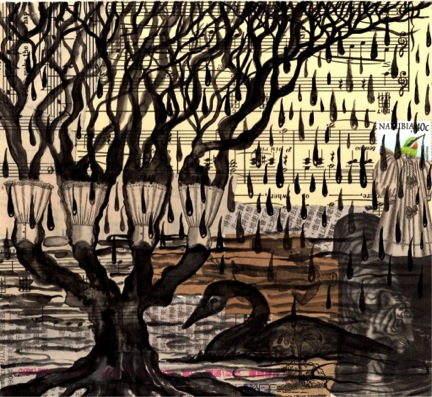By Andrew Evans via National Geographic Traveler

Visual artist Jacqueline Bishop in her New Orleans studio. (Photo by Andrew Evans, National Geographic Travel)
I first met Jacqueline Bishop down in Cuba, where we both found Havana reminiscent of her own hometown, New Orleans. A seasoned traveler and visual artist, Jacqueline takes her inspiration from the natural world and its wettest places, be it Bangladesh, the Amazon, or her own beloved Louisiana swamps. In search of the real “Rhythms of the South”, I was glad for the chance to meet up again with Jacqueline in her white-walled studio in the Lower Garden District. As the summer rain fell outside, our conversation ranged from oil contamination to her celebrity neighbors, to where to find the best meal in town.
Explain your migration to New Orleans.
I was born in Southern California then moved to Kansas City, Missouri, then the Dominican Republic. After the Caribbean, New Orleans felt natural. This city is the Upper Caribbean—not just Spanish or French but combined with Africa and all the different people from the past. I’ve been here forty years and I cannot imagine living anywhere else.
What feels most Caribbean about it?
Oh, the architecture, the food, the music, the rhythm in the streets—the fact that there’s music in the streets and the fact that you can get a decent cup of coffee on every corner. Also, it’s the attitude of the people who live in New Orleans—we’re separate from the United States. We have our own law, we have our own culture.
What does that mean for you as an artist?
I think I have more freedom to express here, because we are a poor state. There is less money to dictate what should be done with the arts.
What’s the downside?
(Laughs) We are a poor state, so there is less money being made in the arts.

Underworld, 2012, Oil on panel, 12 x 12 inches,
13 x 13 inches (framed)
Describe your work as an artist.
My work focuses on environmental issues, both global and local. It reflects thirty years of my travels in Asia and the Americas, and certainly exploring my own backyard in Louisiana. I use different materials from the landscape and paint—I’m a painter. I make collages and do printmaking and watercolor. I started making watercolors from the Amazon River—I would take my collages to Brazil and create these watercolors from the land. I made it so that each piece could not be made anywhere else in the world except right at that place. And once I left it would be different and I would never be able to go back to that place because of the changes in the landscape.

Before the Storm, 2012, Oil on belgian linen, 28 x 26 inches
What do you care most about?
I am very interested in the issue of extinction. We seem to be headed towards a rapid acceleration of disappearing habitats for wildlife and for humans. Water, air, soil and food chain quality have all deteriorated so quickly.
The devastation that followed Katrina revealed a lot of the secrets of this area. It made people elsewhere look at the situation where they lived. It wasn’t like they could say, “It’s way over there, it doesn’t matter,” because it filtered into so much of the rest of the country. It was a total devastation here—80% of the city was under water.
It seems like it has to be that kind of drama, where people’s live, livelihoods, and evidence of their own existence are affected, before we realize the kind of impact we are having. Katrina was in 2005—then in 2010 we had the BP oil spill and another huge landscape devastation. We’re still fighting to receive compensation for BP and we see now, it’s revealed, how deeply the legislature is involved with BP. What more does it take for us to put our money and policies into clean water, clean air, clean soil and build up our wetlands and stop the coastal erosion? I will continue to deal with these issues, but it doesn’t look very good.

Oil Rain (Courtesy of Jacqueline Bishop and Arthur Roger Gallery)
How do you stay hopeful?
I stay busy in the work and I am positive. I have purchased a small cottage in a country town in Mississippi that’s not near any water. I have as studio there. I am gearing up for whatever could happen. But I will continue to live in New Orleans for as long as I can and make my art because it is my home. I have been here for more than half of my life and I don’t really feel comfortable anywhere else. And I’m not leaving.
I’ve heard a lot of New Orleanians say, “I’m never leaving”, and yet they all seem to have contingency plans.
You have to have a plan B. If you’re in Sacaramento with that levee system, if you’re in North Carolina or if you’re in New York with that subway system. If you’re in DC or Cape Cod, if you’re on any coast in America, you always have to have a Plan B.
How does that affect the mentality of this city?
There’s a lot of people who have a Plan B, whether they’re talking about it or not. There’s a lot of development going on in lowland areas of New Orleans and I think it’s great what they’re doing, but they need to have a Plan B.
How did Katrina affect your work?
When it happened here, I couldn’t paint for a year. Words felt more important to me. I was writing. I was trying to find answers. I didn’t know if I was going to have a gallery to show my work, or if my husband would still have a business. I didn’t know where my friends were. There was no time to do anything but figure out how to survive and how to carry on.
It might be similar to what war is like. Once there’s a devastation, you don’t know your future. You just clean up the yard, you clean up what the looters did, but nobody’s around and there is nowhere else to go.

Long, Long Ago, 2010, Ink on collage, 24 x 66 inches, 69 1/2 x 28 inches (framed)
Hurricane Katrina took place nearly a decade ago. Haven’t people moved on?
There’s not a day that goes by that you don’t hear the word Katrina, because everything happened ‘pre-Katrina’ or ‘post-Katrina’. Perhaps not so much with the newbies that have just moved here, but for New Orleanians and the people who came right before or right after, [Hurricane Katrina] is the watermark.
What does that watermark symbolize?
It means that New Orleans is a very different place than it was before Katrina. The storm revealed so much about poverty, environmental issues, and politics—we know that it could happen again, so we have to make a plan. People have become more environmentally conscious and it’s certainly changed the views and focus of a lot artists.
A lot of artists have moved here—thousands and thousands have relocated to New Orleans, and there are so many emerging artists locally. We have new galleries. Before Katrina, nobody knew St. Claude—a lot of musicians came from that area, so it was family. Now we have 18 galleries over there. It’s a kind of statement, like a protest: We’re staying, we’re entrepreneurs, and we need a place to show our work.
What is it about New Orleans that makes so many artists want to be here?
This is the Last Bohemia left in the United States. It’s real. We have soul! Our architecture has been saved. We celebrate decay. We celebrate death. We celebrate the dark shadows in the French Quarter. We celebrate our history and architecture and food and everything that goes into it. That’s part of the tapestry of this old place. It’s not like Houston or LA where they tear it down ‘cuz it’s old. With real estate, if your house isn’t old, it’s not worth anything here. If it’s 17th, 18th or early 19th Century, it’s worth much more than something that’s new.
There’s a lot of poetry in decay—there’s a lot of creative energy around that history. I think that affects a creative person’s psyche and their inner voice about their own creative process.

World View, 2010, Oil on Belgian linen, 34 x 42 inches, 35 1/4 x 43 1/4 inches (framed)
What aspect of your work reflects New Orleans?
It’s all about the decay and the water that we are surrounded by. A lot of my paintings present a waterscape with things happening in it. I use the materials from the landscape—I collect Mississippi River water that I use in my watercolors, and water from the Gulf of Mexico, especially after the BP Oil Spill, with the Corexit in it. I fill bottles and date them, then mix it with the watercolors and use it over the news press collage. For the last 25 years I’ve collected garbage from these streets; I’ve started collecting baby shoes and painting landscapes on them.
I think New Orleans is very romantic and surreal—the fact that we are surrounded by nature, the fact that it’s always creeping and changing around, you can’t help but work with that! It’s about the wildlife and the natural world coexisting with who we are as human beings down here in this hidden place. You know, we live next door to cemeteries that are above ground, and we have parades and musical performances when someone dies. We don’t always have to paint something when the paint flakes off. We like the decay and the history underneath. New Orleans is layer after layer after layer and I think my work reflects that.
Where should visitors go to experience the real wildlife of New Orleans?
Just go downtown and you’ll see the different insects and vines growing up those beautiful buildings. Go to Honey Island, or Jean Lafitte National Park where in April you’ll see the prothonotary warblers and red-winged blackbirds mixed in with the purple Louisiana irises, and all those colors! We have 424 different bird species in Louisiana and we have 12 species of oak trees. Or just go and investigate in City Park and Audubon Park which are both over 100 years old and have areas where it’s not manicured—it’s wild. But even people’s backyards! Sometimes alligators come into the city. Coyotes come into the city because they’re losing their habitat. So there’s snakes and lizards and possums—they’re all here.
You also live in the Garden District.
Well this is the Lower Garden District—I’m right on the line, but the Garden District was the first real suburb in the United States. It was settled by Americans and Europeans who were not living in the French Quarter, because that’s where the refined, wealthy, educated creoles lived. Different families built the plantations here and they had all the gardens. For example the house next door used to be a horse stable.
Today the neighborhood is a mix of writers, artists and old New Orleans families. A lot of waiters live here because with all the different restaurants in the area, they can just walk to work. Anne Rice used to live around the corner. John Goodman lives down the street, and so does Sandra Bullock. But then these celebrities will be living right next door to a waiter, or a poet, a policeman. That’s New Orleans.
How do you break through the many layers of New Orleans?
It all depends on the tourist. Some folks go to Bourbon Street and never leave, so they never see New Orleans. You have to get away from Bourbon Street and be savvy and ask locals where they eat and go to hear music and see art. Find out what locals do, because they have their favorites. Also, New Orleans is made up of hundreds of neighborhoods, and each one has their own little restaurant. I would go out and investigate all those neighborhoods—that’s how you find out about New Orleans.
Any personal restaurant recommendations?
I lean towards Louisiana contemporary Creole cuisine, so I like Clancy’s, Bacchanal, Tujague’s, and Upperline. JoAnne Clevenger, she’s from out in the country and I’ve known her for 30-something years. She first had a little flower cart in the French Quarter and now she has one of the finest restaurants in New Orleans. Anderson Cooper’s always in there. My favorite dish is the black drum meunier, which is sautéed and then laid on greens and cornbread—divine! They’ve got great desserts, too.
There are so many new restaurants—Coquette is very good. The chef is from Maryland but he reflects Louisiana cuisine. And you can’t go wrong with any of the Brennan Restaurants . . . and Antoine’s. We have our own waiter there—Charles. We’ve been using him for twenty years. We first had his uncle, then his father, now him.
Oh! And Herbsaint. Donald Link ranks in my top 5 chefs in the city. He also does Cochon and the Butcher, and they’re both superb.
What do you miss most about New Orleans when you’re away?
Two days ago I was flying home and I happened to be sitting by the window. It was in the daytime and when I saw Louisiana with water on both sides and I saw the wetlands, I took a picture and put it on Facebook with the caption, “I am so glad to be home back in the swamps.” I’m a swamp girl. It’s that closeness with the earth—you know everything is tingling with life. It’s the most misunderstood ecosystem in the world and I live in it! I find that to be special. You can’t find that anywhere else.
